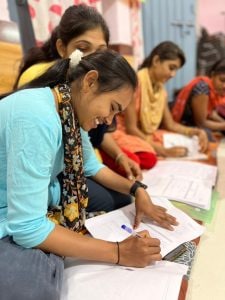

Representational image. Moneycontrol
According to projections, India will overtake China as the world’s most populous country by April, 2023. However, a more significant milestone is that India will have the largest population of working age (15-64) than any other country in the world. With an average age of 29, the demographic bulge is forecasted to continue till 2050, with the largest growth in the coming decade. This has created a demographic dividend which provides an unprecedented opportunity for economic development.
But will a bigger working age population naturally lead to better productivity and economic growth? In India, for instance, there are many obstacles to capitalize on this opportunity. To begin with, ~90% of the jobs in India are informal which means most of the workers don’t have regular salaries and usually cannot access most of the social security benefits. More alarming is that the Female Labour force participation rate has been declining steadily and stands at 20 per in 2021 – one of the lowest in the world and positioning India with MENA (Middle east and North Africa) region. Further, various reports have suggested that less than 3% of the proportion of labour force has received any sort of formal trainings.
Further, a particular section of concern, young people (15-29) in India are particularly vulnerable to marginalization in the labour market because of various reasons – lack of skills and work experience, access career guidance and information asymmetry. COVID-19 pandemic hit the youth segment much more severely and India is the only country where youth employment situation deteriorated in 2021 as compared to 20203. Irrespective of the different definitions of ‘youth’ in India, the rural youth population accounts for roughly 67 per cent of the total population which means that the demographic dividend is indeed inclined towards the rural India. Accounting for more than a 2/3rd of the youth population, India’s rural youth have a unique opportunity to influence India’s economy and the society.
If India is to achieve the SDG Goals – especially towards quality education, gender equality, decent work & economic growth and industry, innovation & infrastructure – the top priority should be catalysing employability and entrepreneurship opportunities for rural youth.
There are several opportunities to work around this area:
Universal access to career guidance and counselling
Due to better penetration of internet in the rural areas, a large segment of the rural youth now aspires to move out of agriculture and wants a white collared job but don’t have access to such avenues. Hence improving trainings for these jobs along with counselling on available opportunities with a clear career progression graph will help these young people take an informed choice. In order to effectively train our youth and improve their employability and entrepreneurial abilities, it is critical to work on promoting universal outreach awareness programmes including career guidance and counselling not just for the youth but also the community in large.

Image credits: Transforming Rural India Foundation
Rethinking skilling infrastructure
While the pandemic impacted the skill development programs severely, it also forced people to rethink the operating structure of the skill development programs in India. While most of the vocational education and training providers in high income countries were able to shift to remote training, very few organizations in India were able to provide virtual trainings and stopped training programs completely – especially in rural India. India needs to revamp the skilling ecosystem for enhancing employability and entrepreneurial stint in the youth. There is a critical need to pivot and develop technology enabled learning opportunities to bridge the gap between the demand and supply particularly in rural skill training programmes. Both the public and the private sector will have to step up their game to facilitate better interactions between the supply and demand cohorts/groups. Simultaneously, one has to also work in the supply to be able to meet the demand size through improved training programmes – blended learning methods (phygital) & improved training infrastructure at the district/block levels that shall cater to the needs of the diverse socio-economic communities of our India

Image credits: Transforming Rural India Foundation
Mass flourishing of nano/micro enterprises in rural India
The rural youth is more aspirational today than ever. There is better access to modern media and transport, and improved overall connectivity. Rising aspirations and better education together add-up to an unprecedented opportunity for promoting self-employment, small businesses and bringing nascent or established businesses to rural India. Entrepreneurship has the power to create hyper-local opportunities for youth in the primary, secondary, and tertiary sectors and increase the annual household income many-fold – it is a catalyst to rural development. Overall, a paradigm shift – accelerated by hyper-local entrepreneurship – is needed in the employment ecosystem such that rural youth are able to access employment that sustains dignified living. This can be achieved by creating a district level and place-based enterprise support ecosystem that creates access to knowledge, business ideas, grant and financing products, services and market linkages for youth to start or grow businesses.
Employability and entrepreneurship are critical to harness energy and create productive economic involvement for youth in India. To achieve the ambitious goals of India@100, it will be critical to train the youth workforce through technology enabled education and skilling programmes and improve entrepreneurial abilities, employability. So on this National Youth Day, lets pledge to work towards enabling rural youth to become an economically independent and shape the Indian and global society and economy.
Neeraj Ahuja is Senior Manager (Mass Rural Entrepreneurship Program) at Transforming Rural India Foundation, and Aliva Das is Senior Manager (Youth Initiative) at Transforming Rural India Foundation. Views are personal.
Read all the Latest News, Trending News, Cricket News, Bollywood News,
India News and Entertainment News here. Follow us on Facebook, Twitter and Instagram.